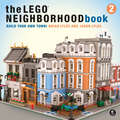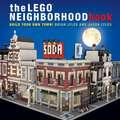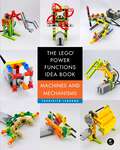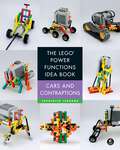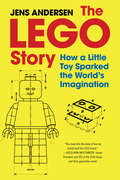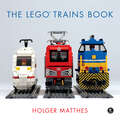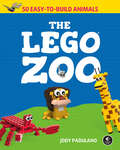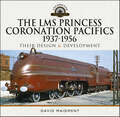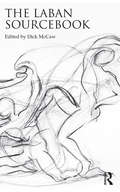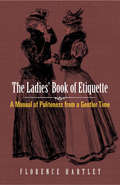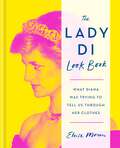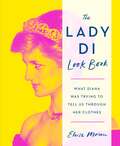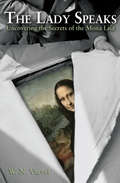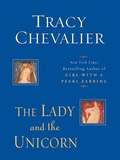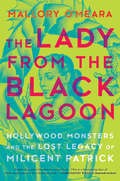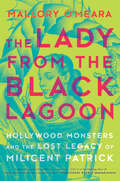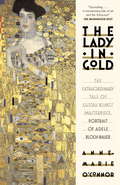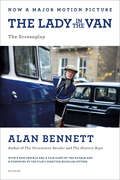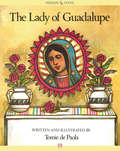- Table View
- List View
The LEGO Neighborhood Book 2: Build Your Own City!
by Brian Lyles Jason LylesStep-by-step instructions show how to build detailed LEGO models of neighborhoods - complete with homes, stores, restaurants, barbershops, and more.Enter the fantastical world of model building. The LEGO Neighborhood Book 2 is a full-color guide to creating intricate, bustling LEGO neighborhoods, and cities. In this second volume, a follow up to the runaway best-selling first volume, you'll learn even more ways to create classic architectural styles using only LEGO bricks. In addition to creating entire buildings, LEGO model-building experts Brian and Jason Lyles also show you how to create interesting architectural features like cornices, false fronts, porches, and detailed interiors and furniture. With instructions for three buildings and many smaller builds, The LEGO Neighborhood Book 2 is sure to provide hours of building fun and inspiration for readers of all ages.
The LEGO Neighborhood Book: Build Your Own LEGO Town!
by Brian Lyles Jason LylesIn The LEGO Neighborhood Book, you’ll create buildings with real-world details like cornices and facades, and try your hand at interior design by filling your buildings with furniture and light fixtures. Then add the finishing touches to your models with plants, traffic lights, scaffolding, and park benches. Snap together a few houses, shops, and apartment buildings to create your own neighborhood!Inside you’ll find:–Complete, step-by-step instructions for four multistory buildings–Dozens of inspiring ideas to use in your own models–Mini builds for a recliner, old-time lamp post, traffic light, and more–A gallery of the authors’ designsFor ages 10+
The LEGO Power Functions Idea Book, Volume 1: Machines and Mechanisms
by Yoshihito IsogawaThis first volume of The LEGO Power Functions Idea Book, Machines and Mechanisms, showcases small projects to build with LEGO Technic gears, motors, gadgets, and other moving elements. You’ll find hundreds of clever, buildable mechanisms, each one demonstrating a key building technique or mechanical principle.You’ll learn to build sliding doors, grasping claws, rack-and-pinion mechanisms, and ball-shooting devices of every sort!Each model includes a list of required parts and colorful photographs that guide you through the build without the need for step-by-step instructions. As you build, you’ll explore the principles of simple machines, gear systems, power translation, and more.
The LEGO Power Functions Idea Book, Volume 2: Cars and Contraptions
by Yoshihito IsogawaThis second volume of The LEGO Power Functions Idea Book, Cars and Contraptions, showcases small projects to build with LEGO Technic gears, motors, gadgets, and other moving elements. You’ll find hundreds of clever, buildable mechanisms, each one demonstrating a key building technique or mechanical principle.You’ll learn to build four-wheel drive cars, adorable walking ‘bots, steerable tanks, robotic inchworms, and cars that can follow the edge of a table!Each model includes a list of required parts and colorful photographs that guide you through the build without the need for step-by-step instructions. As you build, you’ll explore the principles of gear systems, power translation, differentials, suspensions, and more.
The LEGO Story: How a Little Toy Sparked the World's Imagination
by Jens Andersen“Absolutely essential reading for every LEGO fan.” —BlocksThe definitive history of LEGO, based on unprecedented access to the company’s archives and rare interviews with the founding family that still owns the company"This book tells the story of how my family built the LEGO brand." —Kjeld Kirk Kristiansen, former President/CEO of the LEGO Group and 3rd generation ownerIt’s estimated that each year between eighty and ninety million children around the globe are given a box of LEGO, while up to ten million adults buy sets for themselves. Yet LEGO is much more than a dizzying number of plastic bricks that can be put together and combined in countless ways. LEGO is also a vision of the significance of what play can mean for humanity.This book tells the extraordinary story of a global company and a Danish family who for ninety years have defended children’s right to play—and who believe grown-ups, too, should make the time to nurture their inner child. The LEGO Story is built on Jens Andersen’s unique access to LEGO’s own archives, as well as on Andersen’s extensive conversations with Kjeld Kirk Kristiansen, former president and CEO of the LEGO group and grandson of its founder, Ole Kirk Christiansen.A riveting cultural history of changing generations’ views of childhood and the importance of play, The LEGO Story also a fascinating case study of how innovation and creativity helped leaders transform LEGO from a small carpentry business into the world’s largest producer of play materials and one of the most beloved brands in the world. Richly illustrated with never-before-seen photos from the family’s private archive, this is the ultimate book for fans of LEGO, revealing everything you ever wanted to know about the brand.
The LEGO Trains Book
by Holger MatthesLearn the model-making process from start to finish, including the best ways to choose scale, wheels, motors, and track layout. Get advice for building steam engines, locomotives, and passenger cars, and discover fresh ideas and inspiration for your own LEGO train designs.Inside you'll find:-A historical tour of LEGO trains -Step-by-step building instructions for models of the German Inter-City Express (ICE), the Swiss &“Crocodile,&” and a vintage passenger car -Tips for controlling your trains with transformers, receivers, and motors -Advice on advanced building techniques like SNOT (studs not on top), microstriping, creating textures, and making offset connections -Case studies of the design process -Ways to use older LEGO pieces in modern designsFor ages 10+
The LEGO Zoo: 50 Easy-to-Build Animals
by Jody PadulanoA children's book that shows how to build 50 simple models of LEGO animals using only standard LEGO parts that every LEGO fan has in their collection.The LEGO Zoo book shows kids of any age how to build 50 simple animal models using only standard LEGO parts that are already likely to be in their collection. You'll learn how to build models of animals like crocodiles, zebras, wolves, lions, flamingos, plus many more. Projects are ordered by increasing difficulty making it easy to jump in without getting in over your head. The animals are so cute and goofy, whether building as a family or solo The LEGO Zoo is sure to deliver a roaring good time!
The LEGO® Engineer
by Jeff FriesenLEGO® bricks meet The Way Things Work in this fun, informative tour of the world of engineering, from the creative mind of expert LEGO® builder Jeff Friesen.In The LEGO® Engineer, you&’ll explore how some of humanity&’s greatest feats of engineering work, from towering skyscrapers to powerful rockets to speeding bullet trains. Then follow step-by-step instructions to build these marvels with LEGO® bricks as you experience the world of engineering in a fun new way.How do diesel and electric engines work together to drive massive freight trains? How does a container ship&’s bow shape contribute to its fuel efficiency? How do cable-stayed bridges distribute weight differently than suspension bridges? You&’ll learn the answers to these engineering questions and more as you build your way through over 30 models, all designed by LEGO® expert Jeff Friesen. Understanding the engineering principles behind these structures will not only help you better appreciate the world around you, but will also help you make your own LEGO® builds more realistic.
The LMS Princess Coronation Pacifics, 1937–1956: Their Design & Development
by David MaidmentThis book covers the design, construction, operation and performance of Sir William Stanier’s masterpiece, the Princess Coronation pacific locomotives, better known as the ‘Duchesses’. Included are pen portraits of the LMS engineers, a chapter on the express locomotives of the early LMS period that preceded their introduction and the internal rivalries and politics that Stanier was brought in to resolve. Chapters and photographs cover the streamline era, the war years and aftermath, the early years of nationalization including the 1948 locomotive exchanges and the recovery of performance in the mid-1950s. The author includes some of his own experiences and photographs. The book includes 200 photographs including a few in color from the LMS era, and an appendix with weight diagrams, and statistics of the locomotive construction and withdrawal, names, liveries, allocations and mileages.
The Lab Book: Situated Practices in Media Studies
by Jussi Parikka Darren Wershler Lori EmersonAn important new approach to the study of laboratories, presenting a practical method for understanding labs in all walks of life From the &“Big Science&” of Bell Laboratories to the esoteric world of séance chambers to university media labs to neighborhood makerspaces, places we call &“labs&” are everywhere—but how exactly do we account for the wide variety of ways that they produce knowledge? More than imitations of science and engineering labs, many contemporary labs are hybrid forms that require a new methodological and theoretical toolkit to describe. The Lab Book investigates these vital, creative spaces, presenting readers with the concept of the &“hybrid lab&” and offering an extended—and rare—critical investigation of how labs have proliferated throughout culture.Organized by interpretive categories such as space, infrastructure, and imaginaries, The Lab Book uses both historical and contemporary examples to show how laboratories have become fundamentally connected to changes in the contemporary university. Its wide reach includes institutions like the MIT Media Lab, the Tuskegee Institute&’s Jesup Wagon, ACTLab, and the Media Archaeological Fundus. The authors cover topics such as the evolution and delineation of lab-based communities, how labs&’ tools and technologies contribute to defining their space, and a glossary of key hybrid lab techniques.Providing rich historical breadth and depth, The Lab Book brings into focus a critical, but often misunderstood, aspect of the contemporary arts and humanities.
The Lab: Creativity and Culture
by David EdwardsNever has the spirit of innovation been more highly valued than today. Around the world, people see the hard-to-teach skills of creativity as the lifeblood of cultural change and the engine of economic development. In The Lab, David Edwards presents a blueprint for revitalizing labs with "artscience"? creative thought that erases conventional boundaries between art and science?to produce innovations that otherwise might never see the light of day. At the heart of The Lab is "cultural incubation," whereby ideas translate with free-wheeling public exchange through a kind of innovation funnel—from educational settings (as in The Lab at Harvard University), to cultural settings (as at Le Laboratoire in Paris and elsewhere), to realizations as innovative products or humanitarian initiatives (within LaboGroup and other translation labs around the globe). With examples ranging from breathable chocolate (Le Whif) to contemporary art installations that explore the neuroscience of fear, Edwards shows how a measured-risk, seed-investment, mentorship-focused network of labs can allow exotic, unexpected ideas to flourish without being killed off at the first hint of impracticality. Unique to the innovation funnel is how creator risk is encouraged but also managed by mentors and others in each lab, so that the most daring ideas—lighting African villages with microbiotic lamps, or cleaning the air with plant-based filters—can emerge within passionate and sometimes inexperienced creative bands. Lively and engaging, replete with anecdotes that bring Edwards's unique personal experience in developing artscience labs to life, The Lab approaches innovation from exciting new angles, finding invigorating ways to repurpose our most creative assets—in scientific exploration, artistic imagination, and business model-building. David Edwards teaches at Harvard University in the School of Engineering and Applied Sciences. His creative work is described at www.davidideas.com.
The Laban Sourcebook
by Dick McCawRudolf Laban (1879 – 1958) was a pioneer in dance and movement, who found an extraordinary range of application for his ideas; from industry to drama, education and therapy. Laban believed that you can understand about human beings by observing how they move, and devised two complimentary methods of notating the shape and quality of movements. The Laban Sourcebook offers a comprehensive account of Laban’s writings. It includes extracts from his five books in English and from his four works in German, written in the 1920s and translated here for the first time. This book draws on archival research in England and Germany to chart the development of Laban’s groundbreaking ideas through a variety of documents, including letters, articles, transcripts of interviews, and his unpublished Effort and Recovery. It covers: The beginning of his career in Germany and Switzerland in the 1910s. His astonishing rise to fame in Germany in the 1920s as a dance teacher, choreographer and creator of public dance events. Following his move to England in 1938, the application of his ideas to drama, education, industry, and therapy. Each extract has a short preface providing contextual background, and highlighting and explaining key terms. Passages have been selected and are introduced by many of the world’s leading Laban scholars.
The Labyrinth of the Spirits: From the bestselling author of The Shadow of the Wind
by Carlos Ruiz ZafonAs a child, Daniel Sempere discovered among the passageways of the Cemetery of Forgotten Books an extraordinary novel that would change the course of his life. Now a young man in the Barcelona of the late 1950s, Daniel runs the Sempere & Sons bookshop and enjoys a seemingly fulfilling life with his loving wife and son. Yet the mystery surrounding the death of his mother continues to plague his soul despite the moving efforts of his wife Bea and his faithful friend Fermín to save him.Just when Daniel believes he is close to solving this enigma, a conspiracy more sinister than he could have imagined spreads its tentacles from the hellish regime. That is when Alicia Gris appears, a soul born out of the nightmare of the war. She is the one who will lead Daniel to the edge of the abyss and reveal the secret history of his family, although at a terrifying price.The Labyrinth of the Spirits is an electrifying tale of passion, intrigue and adventure. Within its haunting pages Carlos Ruiz Zafón masterfully weaves together plots and subplots in an intricate and intensely imagined homage to books, the art of storytelling and that magical bridge between literature and our lives.Read by Daniel Weyman(p) Orion Publishing Group 2018
The Ladies' Book of Etiquette: A Manual of Politeness from a Gentler Time
by Florence Hartley"Politeness is goodness of heart put into daily practice," declares the author of this 1860 guide to good manners, adding, "there can be no true politeness without kindness." Florence Hartley's world of calling cards and horse-drawn carriages may seem remote, but her advice is ageless. Friendliness, courtesy, and regard for other people's feelings remain the basis of etiquette for gentlemen as well as ladies. After all, it's just as rude today to neglect guests or finish someone else's sentences as it was in the nineteenth century.This vintage manual abounds in tips for proper behavior in every situation, from hosting dinner parties ("See that no guest is left in silence from the want of attention") and taking public transportation ("Make room for others if you see that the opposite side is full") to choosing clothes ("Do not be too submissive to the dictates of fashion"). Historical context adds a flavorful charm to advice on conducting morning calls and engaging in proper ballroom etiquette. Between its fascinating glimpses of a bygone era and its enduringly sound, common-sense suggestions, this book offers a uniquely instructive guide for navigating life with grace and confidence.
The Ladies' Hand Book of Fancy and Ornamental Work: Directions and Patterns from the Civil War Era
by Florence HartleyDiscover the techniques behind museum-quality pieces and treasured heirlooms with this guide to antique needlework and handcrafts. Originally published in 1859, The Ladies' Hand Book of Fancy and Ornamental Work offers well-illustrated instructions for making the kinds of highly decorated items prized by Victorian homemakers: quilts, doilies, cushions, and ornamental knick-knacks as well as embellishments for collars, hair ornaments, purses, and other items. More than 262 engraved patterns, drawn from English, French, and German sources, encompass a tremendous array of handcrafts: applique, bead work, braiding, crochet, embroidery, knitting, knotting, lace-work, netting, patchwork, quilting, tapestry, tatting, and many other techniques. A rich source of authentic patterns, this volume also provides a historic view of the lives of nineteenth-century women in terms of their pastimes and their forms of creative self-expression.
The Lady Di Look Book: What Diana Was Trying to Tell Us Through Her Clothes
by Eloise Moran***Fashion writer Eloise Moran has studied thousands of pictures of Princess Diana over the past few years. Looking carefully at Diana's clothes, she discovered that behind each outfit lies a carefully crafted strategy. What Lady Di couldn't express verbally, she seemed to express through her clothes.With The Lady Di Look Book Eloise Moran takes us on a photographic journey celebrating Princess Diana's fashion choices over the years. From the pink gingham pants and pastel-yellow overalls of a sacrificial lamb - to the sexy Versace mini dresses, power suits, and cycling shorts of a free woman; this is an interpretation of Diana's most show stopping eighties and early nineties outfits and of course, her most fearless post-divorce revenge looks. Whether it's '80s cottagecore Diana, androgynous bow-tie Diana, little black dress Diana, or athleisure Diana - there is a look for everyone.Full of wit and humour, The Lady Di Look Book illuminates what a bold, and inspiring fashion icon Diana really was and shows that there's a bit of Diana in all of us.
The Lady Di Look Book: What Diana Was Trying to Tell Us Through Her Clothes
by Eloise MoranThrough a rich and beautiful series of images, British fashion journalist Eloise Moran decodes Princess Diana’s outfits in this smart visual psychobiography of an icon.From the pink gingham pants and pastel-yellow overalls of a sacrificial lamb, to the sexy Versace revenge dresses, power suits, and bicycle shorts of a free woman, British fashion journalist Eloise Moran has studied thousands of pictures of Princess Diana. She soon discovered that behind each outfit lay a carefully crafted strategy: What Lady Di couldn’t express verbally, she expressed through her clothes.Diana’s most show-stopping—and poignant—outfits are all here in The Lady Di Look Book, incisively decoded. Moran sees things no one has before: Why, for example, did Diana have a rotating collection of message sweatshirts? Was she mad for plaid, or did the tartan have a deeper meaning? What about her love of costume jewelry on top of the tiaras and oval sapphire engagement ring? With new interviews from some of the people who dressed Diana, Moran’s book is both a record of what Diana wore and why she wore it—and why we are still obsessed with Lady Di.From 1980s Sloane Ranger cottagecore Diana, to athleisure and Dynasty Di Diana, The Lady Di Look Book is both compulsively delightful and a full biography of the world’s most beloved royal.
The Lady Speaks: Uncovering the Secrets of the Mona Lisa (The\lady Speaks Ser.)
by W.N. VarvelThis thoroughly original work of art history presents a provocative theory about Leonardo da Vinci, the Mona Lisa, and Theological Gender Equality. The famous Mona Lisa smile has mystified viewers and intrigued historians for centuries. Completed in 1515, Leonardo da Vinci&’s masterwork has hidden the lady&’s secret well. Now, after years of research and analysis, W. N. Varvel has decoded the hidden meanings of Mona Lisa. In The Lady Speaks, Varnel reveals the vital message her smile conveys: a secret too dangerous for the artist to acknowledge during his life but one which he hoped future generations would understand and embrace. The coming of the &“New Jerusalem&” depends on the world&’s recognizing what lies behind the Mona Lisa smile. Detailing how the artist wove a calculated fabric of clues, symbols, and images, Varvel establishes not only da Vinci&’s, but also Michelangelo&’s, belief in Theological Gender Equality. In a thrilling achievement of art history detective work, Varvel tracks clues, links previously unnoticed connections, recreates scenarios, identifies villains and heroes, and presents a persuasive case for what the lady must be thinking.
The Lady and the Unicorn
by Tracy ChevalierA tour de force of history and imagination, The Lady and the Unicorn is Tracy Chevalier's answer to the mystery behind one of the art world's great masterpieces--a set of bewitching medieval tapestries that hangs today in the Cluny Museum in Paris. They appear to portray the seduction of a unicorn, but the story behind their making is unknown--until now. Paris, 1490. A shrewd French nobleman commissions six lavish tapestries celebrating his rising status at Court. He hires the charismatic, arrogant, sublimely talented Nicolas des Innocents to design them. Nicolas creates havoc among the women in the house--mother and daughter, servant, and lady-in-waiting--before taking his designs north to the Brussels workshop where the tapestries are to be woven. There, master weaver Georges de la Chapelle risks everything he has to finish the tapestries--his finest, most intricate work--on time for his exacting French client. The results change all their lives--lives that have been captured in the tapestries, for those who know where to look. In The Lady and the Unicorn, Tracy Chevalier weaves fact and fiction into a beautiful, timeless, and intriguing literary tapestry--an extraordinary story exquisitely told.
The Lady from the Black Lagoon: Hollywood Monsters and the Lost Legacy of Milicent Patrick
by Mallory O'MearaIn 1954, movie-going audiences were shocked and awed by Universal Studio’s groundbreaking horror film Creature from the Black Lagoon. As the years passed, the film gained a reputation as a landmark of the monster-movie genre. But only a small number of devotees were aware of the existence of Milicent Patrick who remains, to this day, the only woman to have designed a classic Universal monster.That is, until film producer, horror-aficionado, and Black Lagoon acolyte, Mallory O’Meara begins to investigate rumors about the monster’s creator only to find more questions than answers. Through diligent research, O’Meara learns that the enigmatic artist led a rich and fascinating life that intersects with some of the largest figures of mid-century America, including William Randolph Hearst and Walt Disney.The sudden, premature end to Patrick’s career is defined by circumstances that parallel—uncomfortably so—O’Meara’s own experiences in the film world, an industry that continues to be dominated by men. In a narrative with equal parts mystery and biography, The Lady from the Black Lagoon interweaves the lives of two women separated by decades but bound together by the tragedies and triumphs of working in Hollywood.
The Lady from the Black Lagoon: Hollywood Monsters and the Lost Legacy of Milicent Patrick
by Mallory O'MearaThis acclaimed biography shines a light on a trailblazing woman who created a classic movie monster—and the author’s quest to rescue her from obscurity.As a teenager, Mallory O’Meara was thrilled to discover that one of her favorite movies, Creature from the Black Lagoon, featured a monster designed by a woman, Milicent Patrick. But while Patrick should have been hailed as a pioneer in the genre, there was little information available about her. As O’Meara discovered, Patrick’s contribution had been claimed by a jealous male colleague and her career had been cut short. No one even knew if she was still alive.As a young woman working in the horror film industry, O’Meara set out to right the wrong, and in the process discovered the full, fascinating story of an ambitious, artistic woman ahead of her time. Patrick’s contribution to special effects proved to be just the latest chapter in a remarkable, unconventional life, from her youth growing up in the shadow of Hearst Castle, to her career as one of Disney’s first female animators. And at last, O’Meara discovered what really had happened to Patrick after The Creature’s success, and where she went.A true-life detective story and a celebration of a forgotten feminist trailblazer, Mallory O’Meara’s The Lady from the Black Lagoon establishes Patrick in her rightful place in film history while calling out a Hollywood culture where little has changed since.A Hugo and Locus Award FinalistA Thrillist Best Book of the YearOne of Booklist’s 10 Best Art Books of the Year
The Lady in Gold
by Anne-Marie O'ConnorThe spellbinding story, part fairy tale, part suspense, of Gustav Klimt's Portrait of Adele Bloch-Bauer, one of the most emblematic portraits of its time; of the beautiful, seductive Viennese Jewish salon hostess who sat for it; the notorious artist who painted it; the now vanished turn-of-the-century Vienna that shaped it; and the strange twisted fate that befell it. The Lady in Gold, considered an unforgettable masterpiece, one of the twentieth century's most recognizable paintings, made headlines all over the world when Ronald Lauder bought it for $135 million a century after Klimt, the most famous Austrian painter of his time, completed the society portrait. Anne-Marie O'Connor, writer for The Washington Post, formerly of the Los Angeles Times, tells the galvanizing story of the Lady in Gold, Adele Bloch-Bauer, a dazzling Viennese Jewish society figure; daughter of the head of one of the largest banks in the Hapsburg Empire, head of the Oriental Railway, whose Orient Express went from Berlin to Constantinople; wife of Ferdinand Bauer, sugar-beet baron. The Bloch-Bauers were art patrons, and Adele herself was considered a rebel of fin de siècle Vienna (she wanted to be educated, a notion considered "degenerate" in a society that believed women being out in the world went against their feminine "nature"). The author describes how Adele inspired the portrait and how Klimt made more than a hundred sketches of her--simple pencil drawings on thin manila paper. And O'Connor writes of Klimt himself, son of a failed gold engraver, shunned by arts bureaucrats, called an artistic heretic in his time, a genius in ours. She writes of the Nazis confiscating the portrait of Adele from the Bloch-Bauers' grand palais; of the Austrian government putting the painting on display, stripping Adele's Jewish surname from it so that no clues to her identity (nor any hint of her Jewish origins) would be revealed. Nazi officials called the painting, The Lady in Gold and proudly exhibited it in Vienna's Baroque Belvedere Palace, consecrated in the 1930s as a Nazi institution. The author writes of the painting, inspired by the Byzantine mosaics Klimt had studied in Italy, with their exotic symbols and swirls, the subject an idol in a golden shrine. We see how, sixty years after it was stolen by the Nazis, the Portrait of Adele Bloch-Bauer became the subject of a decade-long litigation between the Austrian government and the Bloch-Bauer heirs, how and why the U.S. Supreme Court became involved in the case, and how the Court's decision had profound ramifications in the art world. A riveting social history; an illuminating and haunting look at turn-of-the-century Vienna; a brilliant portrait of the evolution of a painter; a masterfully told tale of suspense. And at the heart of it, the Lady in Gold--the shimmering painting, and its equally irresistible subject, the fate of each forever intertwined.
The Lady in Gold
by Anne-Marie O'ConnorThe spellbinding story, part fairy tale, part suspense, of Gustav Klimt's Portrait of Adele Bloch-Bauer, one of the most emblematic portraits of its time; of the beautiful, seductive Viennese Jewish salon hostess who sat for it; the notorious artist who painted it; the now vanished turn-of-the-century Vienna that shaped it; and the strange twisted fate that befell it. The Lady in Gold, considered an unforgettable masterpiece, one of the twentieth century's most recognizable paintings, made headlines all over the world when Ronald Lauder bought it for $135 million a century after Klimt, the most famous Austrian painter of his time, completed the society portrait. Anne-Marie O'Connor, writer for The Washington Post, formerly of the Los Angeles Times, tells the galvanizing story of the Lady in Gold, Adele Bloch-Bauer, a dazzling Viennese Jewish society figure; daughter of the head of one of the largest banks in the Hapsburg Empire, head of the Oriental Railway, whose Orient Express went from Berlin to Constantinople; wife of Ferdinand Bauer, sugar-beet baron. The Bloch-Bauers were art patrons, and Adele herself was considered a rebel of fin de siècle Vienna (she wanted to be educated, a notion considered "degenerate" in a society that believed women being out in the world went against their feminine "nature"). The author describes how Adele inspired the portrait and how Klimt made more than a hundred sketches of her--simple pencil drawings on thin manila paper. And O'Connor writes of Klimt himself, son of a failed gold engraver, shunned by arts bureaucrats, called an artistic heretic in his time, a genius in ours. She writes of the Nazis confiscating the portrait of Adele from the Bloch-Bauers' grand palais; of the Austrian government putting the painting on display, stripping Adele's Jewish surname from it so that no clues to her identity (nor any hint of her Jewish origins) would be revealed. Nazi officials called the painting, The Lady in Gold and proudly exhibited it in Vienna's Baroque Belvedere Palace, consecrated in the 1930s as a Nazi institution. The author writes of the painting, inspired by the Byzantine mosaics Klimt had studied in Italy, with their exotic symbols and swirls, the subject an idol in a golden shrine. We see how, sixty years after it was stolen by the Nazis, the Portrait of Adele Bloch-Bauer became the subject of a decade-long litigation between the Austrian government and the Bloch-Bauer heirs, how and why the U.S. Supreme Court became involved in the case, and how the Court's decision had profound ramifications in the art world. A riveting social history; an illuminating and haunting look at turn-of-the-century Vienna; a brilliant portrait of the evolution of a painter; a masterfully told tale of suspense. And at the heart of it, the Lady in Gold--the shimmering painting, and its equally irresistible subject, the fate of each forever intertwined.
The Lady in the Van
by Alan Bennett Nicholas HytnerThe screenplay edition of the major motion picture adaptation, starring Maggie Smith, of Alan Bennett's acclaimed story "The Lady in the Van"From acclaimed author and playwright Alan Bennett, whose smash hit The History Boys won a Tony Award for Best Play, comes the screenplay of The Lady in the Van-soon to be a major motion picture starring Dame Maggie Smith.The Lady in the Van is the true story of Bennett's experiences with an eccentric homeless woman, Miss Mary Shepherd, whom he befriended in the 1970s and allowed to temporarily park her van in front of his Camden home. She ended up staying there for fifteen years, resulting in an uncommon, often infuriating, and always highly entertaining friendship of a lifetime for the author.Read the screenplay of the film destined to be among the most talked about of the year, and discover the unbelievable story of one of the most unlikely-yet heartwarmingly real-relationships in modern literature.
The Lady of Guadalupe
by Tomie De PaolaA gorgeously depicted story of the Lady of Guadalupe and her love for the people of MexicoIn stunning words and images, Tomie dePaola renders the beautiful story of the Mother of God appearing to an indigenous man in Mexico to teach true peace to the native people. In these visitations, the Lady of Guadalupe shows her great love for the Mexican people, and proves that culture need not be obliterated to bring the Christian faith to others. The beauty of the Lady's love is reflected in dePaola's spectacular watercolor illustrations. This is a fixed-format ebook, which preserves the design and layout of the original print book.
